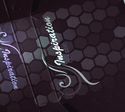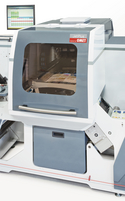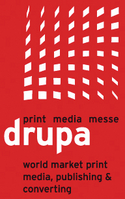Direct from Drupa
14 June 2012Predictably, last month’s Drupa exhibition – the great meeting place for the global printing industry every four years – was the international launch pad for a wide range of new technologies, materials and machinery for the packaging converter
Undoubtedly, one of the highlights of this year’s Drupa show was the launch of the “ground-breaking” Landa Nanographic Printing presses – digital printing with water-based inks at speeds “comparable to offset”. In the words of Landa Corp founder, chairman and CEO Benny Landa: “Nanography is a new technology for applying ink to paper. In developing it we had to re-think and reinvent the printing press. The result is digital printing with remarkable performance – from a family of presses that share stunning ergonomic design, a small footprint and some of the most advanced user functionality available in the market.”
His company, founded 10 years ago following Hewlett-Packard’s acquisition of Indigo, unveilled a family of six Nanographic Printing presses – three sheetfed and three web models. The sheetfed machines include the Landa S10 B1 (41 inch) press, which can print in up to eight colours plus spot and special colours for a range of applications, including short run folding cartons (200-1,000 micron) at up to 6,500 sheets/hour.
Two of the web presses, which can also print in up to eight colours, are aimed at applications including labels and flexible packaging. The Landa W5 is a 560mm web width press capable of single-sided printing at up to 200m/min on films and shrink sleeves (12-250 micron) and on labelstocks, tubestocks, aluminium foil and paper (50-300 micron). The Landa W10 is a 1,020mm web width press, capable of single-sided printing at up to 200m/min on filmstock (12-250 micron) and on paper (50-300 micron).
As the new technology’s Landa NanoInk colourants will be FDA-compliant for food packaging, the W10 should be of interest to mainstream packaging converters.
“Landa Nanographic Printing Presses are intended not to replace offset printing, but to complement it,” said Benny Landa. “For the foreseeable future, offset printing will continue to be the preferred method for producing run lengths of tens of thousands or hundreds of thousands. But the market is demanding shorter and shorter run lengths – and that’s where Nanography comes in – to enable print service providers to produce those short to medium run lengths economically – at offset speeds. That’s what we mean when we say that Landa Nanographic Printing brings digital to the mainstream.”
During the show, Landa Corp officially signed a global strategic partnership agreement with Komori, who will manufacture and market digital printing presses using the Landa Nanographic Printing process for commercial and other printing markets.
Eight years ago, at Drupa 2004, Kodak brought together several companies to form the Graphic Communications Group. In 2008, Kodak launched the Flexcel NX System for digital flexible package printing, and this year, the company was showing off its Flexcel Direct System – the latest in energy-efficient, high power laser engraving technology that “produces superior quality press-ready elastomer sleeves with increased production throughput”. The imager and consumables are designed to work as an optimised solution which, the company says, enables more affordable production of high quality, continuous sleeves for package printing.
Kodak chairman and CEO Antonio M Perez, speaking on the first day of Drupa, explained how the company was now recovering after having filed for Chapter 11 bankruptcy protection in the US at the start of the year. Business is back to normal, he said, and Kodak is “planning its emergence after a difficult few months visiting and reassuring 250 key customers globally”.
But Chapter 11 bankruptcy protection is an excellent tool for restructuring a company with the same strategy and same management, yet without the legacy of costs, he said, adding: “We have come out stronger and leaner.” He expects Kodak to come out of bankruptcy in 2015 and Drupa 2016 “will be a celebration statement”.
Atlas was demonstrating the latest Titan SR9 Series dual turret (DT) slitter rewinder plus its new CW Series technology for primary and secondary slitter rewinders for film and flexible materials.
In the development of the Titan SR9 Series, Atlas said it had focused on achieving significant reductions in machine downtime and operator intervention, along with a reduction of costly waste materials. The SR9 Series technology platform features three separate machine modules of unwind, slitter and rewind sections. The idea is that a converter need only change the rewind section of the slitter from a duplex shaft to a single turret or dual turret configuration, to meet changing production requirements, without the need to change the existing unwind and slitting modules.
The new, more compact, film slitting solutions in web widths from 2.5-10.4m are said to deliver higher efficiency, increased productivity and reliability, higher quality rewind reels, reduced noise levels and more effective, operator-friendly control systems.
The new Atlas CW Series technology platform for primary and secondary slitter rewinders for film and flexible materials was also presented at Drupa. This features wireless rewind arm positioning, automatic knife positioning, direct drive web path rollers and running speeds of up to 1,500m/min with more precise web tension control. Electrical cabinets are now fully integrated into the machines to reduce the space required for installation with ‘under floor’ service trenches also no longer required for the primary slitters.
Avery Dennison announced the European introduction of an HP Indigo-certified digital print-ready version of its high performance Global MDO labelling films for home and personal care products.
“The new Global MDO pressure-sensitive digital facestock provides enhanced productivity for label printers and brand owners looking for brand distinction with operational effectiveness,” said Georg Mueller-Hof, business development director of Avery Dennison Labels and PackagingMaterials Europe.
“It is a digital top-coated product with excellent print quality and optimal ink adhesion. The exceptional strength provided by the 50 micron MDO film and 23 micron polyester liner virtually eliminates line shutdowns due to web breaks.
“The Global MDO digital facestock also makes a significant contribution to the industry’s levels of sustainability,” he added. “Based on the findings of Avery Dennison Greenprint, compared with today’s industry standard PE85 products, it produces 40% less solid waste, consumes 37% less energy and reduces greenhouse gas emissions by 10% because of its lower material usage.”
In addition, Avery Dennison’s new S7000 adhesive technology is said to increase productivity with up to 50% lower ooze and the elimination of adhesive contamination in critical processes. The complete construction is approximately 50% thinner than today’s standard product of PE85 film on glassine liner, so Global MDO delivers almost twice as many labels per roll.
Fujifilm introduced a new surface treatment technology to be used in the manufacture of its Brillia HD PRO-T3 processless printing plate. This MultiGrain Z process is said to allow for the creation of an even greater effective surface area of the plate, resulting in up to a 50% improvement in run length while retaining the plate’s “superior ink/water balance, on-press processing stability and market leading image quality”.
Fujifilm believes that with this new technology, processless plates “will become the defacto standard compared with chemistry-free systems for printers wishing to improve their environmental performance”.
For flexible packaging, Henkel introduced a solvent-free Liofol laminating adhesive based on renewable raw materials that makes it ideal for biofilms. Two solvent-free and TDI-free laminating systems with a long pot life were also presented. The new Liofol adhesives are said to offer very good wetting behaviour, resulting in excellent laminate appearance.
The two systems have a long workability time of up to 60min, which helps to reduce material usage as it allows work to be carried out on the machine without fear that the adhesive will have become unusable when production is resumed. A silane-free adhesion promoter enhances resistance to package contents.
Another Henkel innovation at Drupa was the MiraFoil environmentally compatible metallic effect UV coating – claimed to deliver clear advantages over traditional technologies in terms of sustainability and economy. Even during application, MiraFoil is already said to demonstrate its sustainability strengths in terms of resource conservation. In offset or flexo printing and flatbed or rotary screen printing, and with appropriate machine configurations, the coating can be applied inline just like standard UV coatings. This eliminates the effort and time required for hot or coldfoil stamping, it is claimed.
Another plus is stability: since the effect coating neither foams nor thickens, it can be left in the machine circuits for several days. The latest MiraFoil development is a low migration variety which can be used for food packaging.
The new BLK-6 UV system shown by IST Metz incorporates a series of technological innovations said to facilitate a high standard of efficiency. For example, the new IPS control system adds intelligent options such as remote service and monitoring; while the new miniature UV online sensor, directly integrated into the surface of the reflector, measures the UV radiation efficiency before showing it in the operating display.
Basic components such as the new URS inlay reflectors, the ELC electronic power supply device, or the proven FLC quick-change lamp concept also play an important role in the high performance of the UV system. An inert gas version of the BLK-6 is also available for special requirements, such as in the food packaging sector.
Sweden-based web cleaning specialist Kelva revealed the new Ecoflow Filter – a high-end filter/fan unit for non-contact cleaning, replacing the company’s K-series. The Ecoflow features a more compact design, reduced noise level, automatic off-line filter cleaning and overall lower energy consumption. It comes in a standard version for web widths up to 1.2m with low to medium dust loads. Ease of installation is also promised.
Leonhard Kurz presented a new silver-coloured coldfoil for sheet-fed UV offset printing that the company believes will set a new standard in quality. Luxor/Alufin KPS-OP, according to Kurz, provides consistently good results under a wide variety of application conditions. When it is necessary to apply foil to large areas, the coldfoil will achieve uniform coverage. When filigree details are required, on the other hand, KPS-OP will produce a high edge definition transfer. Even fine rasters are easy to implement, it is claimed.
The new coldfoil was developed for UV offset printing but is equally suitable for conventional offset. It generally adheres equally well to conventional and to UV-cured adhesives, and can be overprinted with conventional drying as well as UV curing inks and lacquers.
Luxor/Alufin KPS-OP can be used to produce a wide variety of metallic colours when overprinted. The foil can also be produced in other colours on request. Light Line KSO is an identical grade with a selection of holographic designs.
The wealth of packaging possibilities offered by Sappi’s most recent portfolio addition was highlighted at Drupa 2012. Designed for lamination to corrugated board, Fusion premium quality, high bright, white liner, is said to deliver “greater shelf shout helping brands ensure their products stand out from the competition”.
Fusion uses 100% bleached virgin fibres to bring out the highest levels of quality – regardless of the printing process – offset, flexo and digital. But its standout feature is said to be its suitability for a range of markets – from corrugators, litho laminators, display manufacturers and folding box converters to direct mailers, preprinters, designers, agencies and co-packers.
According to Sappi, coating and calendering gives the paper surface a special quality and gloss carrying a perception of higher value for money. Key to this is its ability to produce “unrivalled results” on a lower grammage sheet, mirroring the market trend towards lightweighting.
Product manager Bernd Schuldt explained: “Fusion at 180g/m² is 50 to 60 grams lighter than the grades normally specified. This reduction in weight creates savings in the lamination process resulting in a more cost-effective grade. It is also more environmentally friendly as it uses fewer raw materials.”
German manufacturer Topcut Bullmer teamed up with UK distributor Assyst Bullmer and Luxembourg-based software company Eurosystems in unveilling the world’s first 5.2m-wide cutter – the Premiumcut Elc – also naming it the world’s fastest. Operators can precision diecut a wide range of substrates up to 5m wide at speeds of up to 120m/min. The scalable system can be configured from a width of 1.4m. In addition to printed boardstocks produced on machines from major manufacturers such as HP, Agfa and Océ, it cuts materials up to 5cm thick, including Kevlar and glass fibre, textiles, synthetics and fabrics.
Color iQC Print and NetProfiler were new offerings from X-Rite to help print and packaging companies achieve higher efficiencies and improved quality through standardised and automated workflows.
Color iQC Print links seamlessly with the new PantoneLive cloud-based colour service that improves colour matches of labels and packaging across an array of printing technologies and substrates. It allows any company in the workflow to designate jobs or measure colour data in the format it is accustomed to using, and to send data to the next link in the supply chain with confidence that the information will be preserved exactly as it was sent.
The NetProfiler 3.0 software can verify, optimise, and certify handheld and press-side spectrophotometers wherever they are used in the supply chain, ensuring that all stakeholders can use the same colour standards and tolerances.
“Color iQC Print and PantoneLive shave hours off projects by making sure that all the links in the supply chain – from brand owners and designers to product production – have reliable and accurate colour information when and where they need it,” said Richard Knapp, X-Rite product marketing manager, colour and appearance software. “Any brand owner using these tools will have a competitive advantage when introducing new products, in terms of saving time and resources.”
To meet increasing demands from brand marketers for personalised or unique information on packs or labels, Omet, which designs and manufactures printing and converting machines for the narrow and mid-web industry, debuted at Drupa a digital inkjet unit for mounting on its traditional presses. The new JetPlus unit can be combined in-line on the XFlex X6 label presses and, for flexible packaging, on the company’s Varyflex V2 packaging presses. The presses offer flexibility, ease of management, print quality and productivity, the company says, with each machine in the Varyflex, XFlex and Flexy lines designed to the specific needs of the customer.
Pasaban presented its Connectivity Cloud, a system for monitoring machinery over the internet. The tool provides the converter with real-time data, analyses and warnings on the operational state of all Pasaban machines (sheeters, winders, conveyors), regardless of location, via mobile devices or an internet connection. During the testing phase, Pasaban was assisted by Okab, a large paper converter with plants in Germany and Sweden. The machines at both plants were linked to the Pasaban Connectivity Cloud. This connection was demonstrated on the stand.
The company also introduced its new Flexcut and Compact sheeters, which can be connected to the Connectivity Cloud and the Pasaban Online Assistance service. The Flexcut sheeter comes in widths of 1,450mm and 1,650mm and offers operational flexibility, as it supports different automation packages. The Compact is a modular design sheeter that can be installed both on and off-line and integrated into a cut-to-register control system. This model comes in a maximum width of 1,200mm.
Orders on the spot
With customers coming from 30 countries, KBA booked a string of orders for sheetfed offset presses, including major contracts from Italy’s Seda International Packaging Group for three medium and large format Rapidas with a total of 27 printing and coating units, and from Chinese print group Beijing Hongbo Haotian for 23 Rapida 105 medium-format printing units. Claus Bolza- Schünemann, president and CEO of KBA, predicted: “Looking at the many projects initiated at the fair, we anticipate some brisk post-Drupa business.”
BasysPrint completed the sale of its new VLF CTP platesetter to Turkish packaging printer Denba Ambalaj at Drupa 2012, adding to more than 40 other machines already sold during the show.
Over the course of the show, Kodak exceeded its sales goals and received “overwhelmingly positive feedback” from visitors. The company also took multiple orders for Prosper 1000 and 5000XL presses and a large number of Flexcel NX systems. “Drupa has been an extraordinary event on many fronts – for our industry, our customers, and for Kodak,” said chairman and CEO Antonio M Perez.
A new 6-colour Roland 706 LV HiPrint with an inline coater for Hira Print Solutions’ new facility at Mumbai, India, was the first sale announced by Manroland India at Drupa 2012.
Atlas Converting Equipment (UK) reported sales of several Titan slitters, including one Titan ER610 compact machine to a new customer in Germany.
The Cerutti Group signed orders for more than 20 machines, including Flexotecnica’s new EVO-XG press, which was demonstrated at the show.
Benny Landa launched his company’s Nanographic Printing technology at the Drupa show Benny Landa Flexcel Direct laser engaver from Kodak Flexcel Direct The latest Titan SR9 dual turret slitter featured among Drupa demonstrations by Atlas Titan SR9 dual turret slitter Non-contact cleaning: Ecoflow filter replaces Kelva’s K-series Ecoflow filter “Greater shelf shout†for brands packaged in Sappi’s Fusion white liner Fusion A raster image created using Kurz's coldfoil techniques Kurz's coldfoil Drupa 2012 The JetPlus digital inkjet unit adds to the capabilities of existing Omet press lines JetPlus digital inkjet unit External weblinksConverting Today is not responsible for the content of external internet sites.Atlas Converting Equipment Avery Dennison Basysprint Cerutti Fujifilm Henkel IST Metz KBA Kodak Kurz Landa Corp Manroland Omet Pasaban Sappi Topcut Bullmer X-rite









